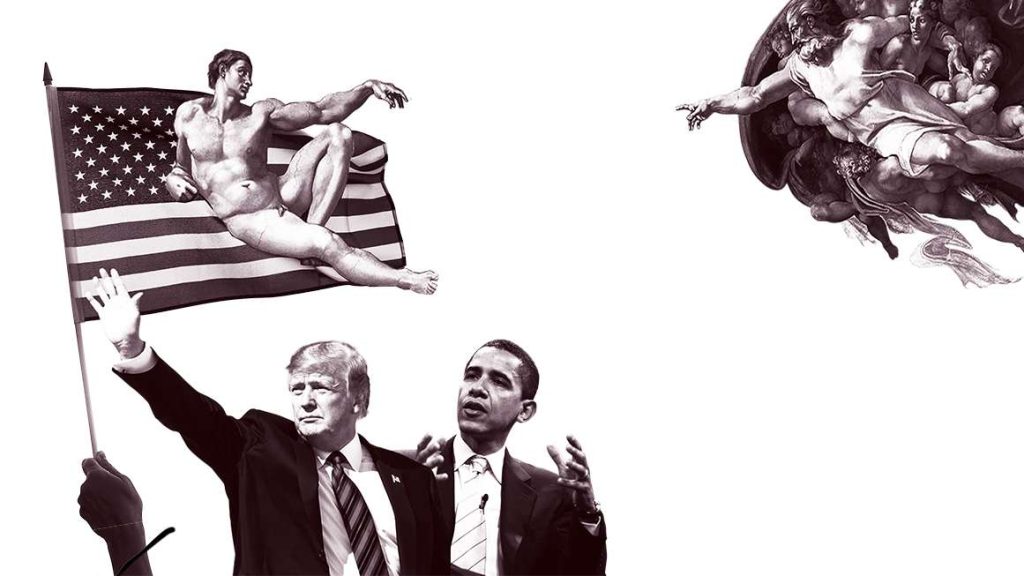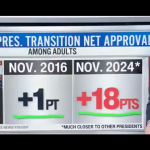“We must end this uncivil war that pits red against blue,” President Joe Biden implored in his inaugural address, a speech that used the word unity no fewer than 11 times: “Unity is the path forward.”
It’s a familiar tune, one we were hearing from presidents long before it started to feel like the country was coming apart. “A kinder, gentler nation” was George H.W. Bush’s formulation. “I’m a uniter, not a divider,” the rendering of his feckless son. Barack Obama wouldn’t just stop the oceans’ rise; through the sheer power of presidential happy-talk, he’d kumbaya us into “one America,” beyond red and blue. Given the way things have been heading lately, you can’t blame Biden for sounding a bit desperate about it.
Donald Trump, who threw out the old playbook on his path to the presidency, takes a different approach: “We will root out the communists, Marxists, fascists, and the radical left thugs that live like vermin within the confines of our country!” “The seal is now broken.””2024 is our final battle.”
That’s really not helping, but neither would it put us on the glide path to national unity if Trump suddenly mellowed his tone. The former president’s apocalyptic rhetoric and rageaholic antics aren’t what made the presidency itself a central fault line of American polarization. It’s the fact that the president, increasingly, has the power to reshape vast swathes of American life. The modern presidency, by its very nature, is a divider, not a uniter. It has become far too powerful to be anything else.
Over the past several decades, as our politics took on a quasi-religious fervor, we’ve been running a dangerous experiment: concentrating vast new powers in the executive branch, making “the most powerful office in the world” even more powerful. Fundamental questions of governance that used to be left to Congress, the states, or the people are now settled, winner-take-all, by whichever party manages to seize the presidency.
Worse still, recent presidents have deployed their enhanced powers to impose forced settlements on highly contested, morally charged issues on which Americans should be free to disagree. In the age of identity politics, the modern president has become our culture warrior in chief. Unless and until he’s disarmed, we’ll have “uncivil war” and American carnage from here to the post-apocalyptic wasteland.
Culture Wars Past
Culture war has become our go-to umbrella term for practically every dispute in American politics that involves deeply held moral values. The phrase came into common currency three decades ago, thanks to an influential 1991 book, Culture Wars: The Struggle To Define America, by University of Virginiasociologist James Davison Hunter—and to Pat Buchanan’s infamous”culture war” speech at the Republican National Convention the next year.
But while some of the flashpoint issues of the time still persist today (the abortion fight we will always have with us, it seems), others—”blasphemous” art, “family values,” creationism in the classroom, naughty lyrics from hair-metal bands—now seem almost quaint.
The culture wars of the late 20th century were tied up with the rise of the Christian Right. The battle lines were religious vs. secular—”orthodox” vs. “progressive,” in Hunter’s formulation. Buchanan’s 1992 convention speech shocked the pundit class by describing the struggle as “a religious war going on in this country.”
Yet this particular Thirty Years’ War wasn’t terribly bloody. The stakes often seemed more symbolic than real. A lot of the fights were literallyabout symbols—desecration of sacred objects: burning the American flag, or, in the controversy over Andres Serrano’s Piss Christ, dunking a crucifix in urine, calling it art, and getting the federal government to write you a check for it.
Most significantly, it wasn’t fought with the weapons of presidential power. Executive orders and administrative diktat were rarely deployed to settle culture-war fights.
Lip Service Is All You’ll Ever Get from Me
Presidents weighed in, to be sure, but it was largely performative. They—or their lieutenants—used the bully pulpit to signal support for teaching “the biblical account of creation” in public schools or to bang on about lax values in popular culture. In a much-noted 1992 speech, then–Vice President Dan Quayle lit into a sitcom character, Candice Bergen’s Murphy Brown, for “mocking the importance of fathers by bearing a child alone and calling it just another lifestyle choice.” But culture-war jawboning rarely cashed out into observable policy change.
Another favorite tactic was backing long-shot constitutional amendments. In 1982, President Ronald Reagan called on Congress to passan amendment protecting “the simple freedom of our citizens to offer prayer in our public schools and institutions,” pronouncing himself “confident that such an amendment will be quickly adopted.” It never came to a vote, and the effort was abandoned after the Democrats took back the Senate in 1986.
Three years later, when the Supreme Court held that flag-burning was protected speech, President George H.W. Bush promptly demanded a constitutional amendment prohibiting flag desecration: “The law books are full of restrictions on free speech. And we ought to have this be one of them.” He got enthusiastic support from the then-chairman of the Senate Judiciary Committee, Joe Biden, who drafted a bill carrying penalties of up to a year in prison for defacing or burning the American flag. That too was struck down by the Supreme Court, and Bush’s constitutional amendment never made it across the goal line.
Executive orders played a minor role at best. For instance, at a United Nations conference in Mexico City in 1984, Reagan announced a new rule requiring U.S. foreign aid recipients to certify they wouldn’t perform or promote abortion as a method of family planning. Two days after being sworn in, the next Democratic president, Bill Clinton, overturned the so-called Mexico City Policy via executive order. Subsequent Republican presidents turned it back on and Democrats turned it off again, the requirement winking in and out of existence each time the office changed parties. The issue was important enough to activists that each new president dutifully flipped the switch in their first days on the job, without meaningfully affecting any American’s rights.
But as presidential power has grown, the consequences of a shift in party control of the White House have grown far more sweeping.
The Imperial Administrative Presidency
As a future Supreme Court justice, Elena Kagan, noted in a 2001 Harvard Law Review article, “Presidential Administration,” modern presidents have accrued significant power over regulatory policy, “making the regulatory activity of the executive branch agencies more and more an extension of the President’s own policy and political agenda.” The process began when bright lawyers in the Reagan administration saw increased presidential authority as a way to ride herd on the regulators and lower burdens on business. But what goes down can come back up, and rise to new heights: As Kagan noted, the president’s administrative authority works just as well to push “a distinctly activist and pro-regulatory agenda.”
The original constitutional design required broad consensus for broad policy changes, but as law professors John O. McGinnis and Michael B. Rappaport warned in an important 2021 article in the Ohio State Law Journal,”Presidential Polarization,” presidents now “can adopt such changes unilaterally….Domestically, Congress’s delegation of policy decisions to the executive branch allows the President’s administration to create the most important regulations of our economic and social life. The result is relatively extreme regulations that can shift radically between administrations of different parties.”
Presidents have become our primary policy makers. Whenever the presidency changes parties, McGinnis and Rappaport note, “rules affecting almost every aspect of American life will pivot 180 degrees.” The shift from Obama to Trump, for example, carried with it reversals on net neutrality rules, fuel economy limits on new vehicles, and which immigrants can come to the United States, as well as new rules governing free speech disputes and sexual assault claims on college campuses across the country.
What’s more, legal changes made by presidential decree may be locked in for as long as the president’s party holds the office—even when there’s majority support in Congress to overturn them. Attempts to rein in presidential lawmaking must themselves run the gauntlet of the ordinary legislative process, subject to presidential signature or veto. The default setting of American government has shifted toward presidential unilateralism. The president now enjoys broad power to do as he pleases unless and until Congress can assemble a veto-proof supermajority to stop him.
In all the discussion of polarization, McGinnis and Rappaport note, “one important factor…has gone largely undiscussed: the deformation of our federal governing structure.” The drift toward one-man rule both intensifies partisan fury and makes it more dangerous.
Racial Preferences With the Stroke of a Pen
In the first week of his presidential administration, Biden unleashed unilateral edicts at such a blazing death-metal pace that even the New York Times editorial board got nervous, imploring him to “Ease Up on the Executive Actions, Joe.” (It took him until week two to remember to reverse the Mexico City Policy on foreign aid for abortion.) By the 100-day mark, Biden had already issued more executive orders than Obama managed in his entire first year.
Few issues divide Americans more than race; one of Biden’s first acts as president was to issue an executive order guaranteed to divide us further. On his first day in office, the president issued an Executive Order on Advancing Racial Equity that makes rooting out “systemic racism” a central organizing principle for the federal government.
This isn’t the old-fashioned notion of racism as individual prejudice based on skin color. It’s an invisible, insidious force that reveals itself in statistical disparities, as Biden had earlier explained at a campaign-trail event hosted by the Rev. Al Sharpton. It’s behind higher poverty rates for black Americans, “undervalued” houses, and “car insurance [that] costs more.” “Most of us whites…don’t even consciously acknowledge it,” Biden added, “but it’s been built into every aspect of our system.”
Under the Biden order, 90-odd federal agencies were tasked with developing “Equity Action Plans” to level those differences. To fulfill that mandate, the Biden Department of Health and Human Services announced in 2021 that it would pay higher Medicare reimbursement rates for doctors who “implement an antiracism plan,” on the grounds that “systemic racism is the root cause for differences in health outcomes.”
Under the theory that where there are racial disparities, there is racism, the administration has mounted a frontal assault on equality before the law. In 2021, for example, the Biden administration began handing out emergency COVID-19 relief funds—debt relief for farmers, grants to restaurants—on an explicitly racial basis. That principle even extended to lifesaving drugs. Minority status alone could move you to the front of the line for COVID antivirals in states following guidelines from Biden’s Food and Drug Administration.
In December, the president used his first veto to defend a government data-collection mandate that requires lenders to gather and report information on small-business loans, including the race, gender, and sexual preference of the business owners. The president’s veto message insists the regulation is a “transparency” measure, enabling “oversight of abusive and predatory lenders.” But in the context of other policies, one could be forgiven for suspecting that the ultimate goal is a racial- and gender identity–based spoils system that delivers benefits to citizens according to their rankings on some kind of intersectionality scorecard.
Commander in Chief of the Girls’ Bathroom
When it comes to transgender issues, most Americans are for tolerance and fair treatment. But they’re deeply divided on issues like allowing biological males to use girls’ restrooms. The president calls such sentiments “hysterical,” “prejudiced,” and “ugly,” but those who share them are unlikely to be harangued into believing that traditional bathroom rules are the new Jim Crow.
Here again the country is getting forced settlements through unilateral edict and administrative order. Title IX of the Educational Amendments of 1972 prohibits discrimination “on the basis of sex” in any program receiving federal financial assistance. In an administrative rule that’s about to be finalized, Biden interprets that authority to let him make national rules about which kid gets to use which bathroom in practically every public K-12 school or college in America.
When it comes to girls’ sports, the administration has hedged its bets somewhat, likely because nearly 70 percent of Americans now say only biological females should be allowed to compete in women’s sports. But the rule Biden’s Education Department has draftedwill prohibit the categorical bans most Americans support in any educational institution receiving federal tax dollars: the vast majority of colleges, universities, and K-12 schools.
On trans health care, they’re steering a bolder course. The president’s June 2022 Executive Order on Advancing Equality for Lesbian, Gay, Bisexual, Transgender, Queer, and Intersex Individuals proposes sending the Federal Trade Commission after doctors practicing “conversion therapy,” which is defined broadly enough (“efforts to suppress or change an individual’s sexual orientation, gender identity, or gender expression”) that it could include psychologists who do not immediately fork over puberty blockers. Biden’s Department of Health and Human Services is moving to implement a rule that requires doctors and hospitals to provide “gender-affirming care,” including for minors: puberty blockers, cross-sex hormones, and “top” and “bottom” surgeries. Private insurers—and the taxpayer, via Medicaid—would be required to foot the bill.
According to a Center for American Progress analysis of the regulation, “a surgeon may be in violation for denying a transgender man a medically necessary hysterectomy because it is part of a gender-affirming care plan if the surgeon would otherwise provide that service to a cisgender woman.” One has to wonder about the selection effects of such a rule: Is it a good idea to limit the future pool of gynecological surgeons to people who will cut the uterus out of a healthy teenager? Even if it was, is making those sorts of calls what we hire presidents to do?
A Federal Bookmobile Czar
Maybe so, in the president’s view—it seems that there’s no social issue too narrow or local not to cry out for intervention by the culture warrior in chief. Lately, Biden has been hell-bent on making a federal case out of how local school districts curate their grammar-school library shelves.
The president has made the fight against so-called “book bans” a key part of his reelection bid. In the video ad launching his 2024 campaign, the president rhapsodizes about “freedom”: “There’s nothing more important, nothing more sacred.” But “around the country, MAGA extremists are lining up to take on those bedrock freedoms”—even “banning books,” the president laments as the camera cuts to a stack of titles with Harper Lee’s To Kill a Mockingbird at the top. “Banning books in schools!” Biden wailed at a campaign event later that summer, “I mean, this the United States of America, for God’s sake. The United States of America!” Ray Bradbury weeps.
Actually, we’re a far cry from Fahrenheit 451. It’s not Atticus Finch in the dock either, unless you count such notorious MAGA strongholds as Los Angeles and Seattle, where To Kill a Mockingbird has been pulled from the curriculum for its insensitive “white savior” storyline. What the president’s calling “book bans” usually involves local taxpayers deciding that Maia Kobabe’s graphic memoir Gender Queer may be too graphic for fourth-graders, or opting to pass on Juno Dawson’s This Book Is Gay, which includes advice on mutual masturbation—”something they don’t teach you in school“—and using Grindr to find sex partners.
Reports of a nationwide wave of book-banning Babbittry have been overhyped by activist groups like PEN America, which defines the term “ban” broadly enough to include “any action taken against a book” that leads to “restricted” or “diminished” access for any period of time. Moved from the middle-school library to the high-school shelves? “Banned.” Removed from a recommended reading list but still on the library shelves? “Banned.”
Do “concerned parents,” or red-state politicians claiming to speak for them, ever go overboard and make nuisances of themselves? Sure: This is a big, crazy country with over 13,000 school districts. And PEN America documents some serious cases of legislative overreach, like a 2022 Missouri law making it a misdemeanor, punishable by up to a year in jail, for librarians to provide “explicit sexual material” to students.
Decisions about what goes on school library shelves should be made at the local level, not forcibly dictated from the state house. Still less should those decisions be dictated from Washington, D.C.
That’s not stopping the Biden administration from bringing the full force of the federal government down on local school districts that aren’t keen on cartoon porn. “We’re taking on these civil rights violations, because that’s what they are,” Biden told the crowd at the White House Pride Celebration in June. He announced the appointment of a “coordinator” in the Education Department’s Office for Civil Rights, tasked with fighting the alleged bans.
The administration’s legal theory, as explained by the president, is that “book bans may violate the federal civil rights laws when they target LGBTQ students or students of color and create hostile classroom environments.” They took that theory for a successful test drive last year, when they threw the proverbial book at a suburban Atlanta school district for removing All Boys Aren’t Blue from its library shelves. The offending tome contains some pretty spicy descriptions of underage cousin-incest—some of which you may even have heard if you caughtthe viral video of Sen. John Kennedy (R–La.) reading them aloud in a deadpan Southern drawl at a 2023 congressional hearing: “He asked me to turn over while he slipped a condom on himself. This was my ass….He got on top and slowly inserted himself into me. It was the worst pain I think I have ever felt in my life. Eventually, I felt a mix of pleasure with the pain.”
After it removed that book, the Forsyth County Schools found itself subject to a federal civil rights investigation into whether it had created a “racially and sexually hostile environment for students.” The Office for Civil Rights (OCR) conceded the district wasn’t engaged in an anti-gay book purge: It had “limited its book screening process to sexually explicit material.” Nonetheless, OCR was troubled by “negative comments about diversity and inclusion” from parents at a school board meeting. As reported in the local press, those comments included statements like, “Do you think it’s healthy for 8‑year-olds to be exposed to books which encourage transgenderism, sexualization, and masturbation?”
To get the feds off their back, Forsyth County had to agree toa number of humiliating terms. OCR required the district to publicly post notice of its fealty to diversity, equity, and inclusion (DEI) thought (“the District strives to provide a global perspective and promote diversity” in its school libraries), circulate information on how aggrieved students can file federal civil rights complaints, and conduct a district-wide harassment audit. As the Foundation for Individual Rights and Expression notes, OCR’s strong-arm tactics succeeded here despite the fact that “there is no legal authority that [says] failure to ‘promote diversity’ violates federal anti-discrimination law. If OCR thinks it can require schools to affirmatively ‘promote diversity’—a term left undefined—what else does the agency think it can get away with?”
We’ll find out as Biden’s new school library czar gets to work.
Culture War on the Conan Principle
Strap in, because it’s about to get worse. The increasingly influential “national conservatives” have nothing but scorn for those who want to limit government power and force the feds to mind their own business. Their aim is to seize power and wield it against their cultural enemies, waging war on the Conan Principle: Crush your enemies, see them driven before you, and hear the lamentations of their transwomen.
Trump is coming down that escalator again, on a mission of vengeance. He’ll take OCR off the “book ban” beat—and instead sic them on teachers who cover critical race theory, transgender issues, or “other inappropriate racial, sexual, or political content.” They’ll face “severe consequences” under federal civil rights law.
As recently as 1996, the Republican Party platform acknowledged that “the federal government has no constitutional authority to be involved in school curricula” and called for abolishing the Department of Education. Now their standard-bearer wants to use $79 billion in federal education funds to work his will on thousands of local school districts. The federal government has no constitutional authority to set qualifications for teachers either, but Trump promises to “create a new credentialing body to certify teachers who embrace patriotic values and the American way of life.”
On transgender issues, Trump promises another 180-degree turn. What Biden deems “gender-affirming care,” Trump calls “child sexual mutilation”; he promises to use federal health care dollars to dictate the proper treatments for gender dysphoria from the White House. He’ll have the Justice Department investigate pharmaceutical companies that make puberty blockers, and he’ll push for a law “prohibiting child sexual mutilation in all 50 states.” Maybe he’ll discover that there’s already a federal female genital mutilation law and encourage some creative prosecutions.
Is This Any Way To Run a Country?
Alexander Hamilton supposed that “energy in the executive” would lead to “steady administration of the laws.” But there are no permanent victories in politics, so that energy can mean whipsawing between radically different policies based on the vagaries of the Electoral College. Puberty blockers and drag queen story hours go from compulsory to forbidden every four to eight years, depending on which political party wins the presidency. At some point you have to ask yourself: Is this any way to run a country?
It’s not just stupid; it’s dangerous. About 60 percent to 70 percent of Democrats and Republicans now view their political opponents as “a serious threat to the United States and its people,” while 42 percent say the other team is “not just worse for politics—they are downright evil.” As McGinnis and Rappaport note: “The imperial administrative presidency raises the stakes of any presidential election, making each side fear that the other will enjoy largely unchecked and substantial power in many areas of policy.”
Partisans have long declared that next November’s is the “most important election in history.” We used to take that with the requisite grain of salt. In 2000, only 45 percent of Americans told pollsters it really mattered who won that year’s presidential election. It went up from there: 63 percent in 2012, 74 percent in 2016, 83 percent in 2020.
Maybe Americans think it matters because, increasingly, it matters. If everything from what books go on school library shelves to who gets to use the girls’ locker room becomes a matter of presidential policy, good luck convincing people to put an electoral loss in perspective. Every election becomes a Flight 93 election: Charge the cockpit, do or die.
We should be heading in the opposite direction: limiting the damage presidents can do, lowering the stakes of presidential elections, and reining in the president’s ability to make law with the stroke of a pen.
One hopes that Americans will rediscover the “better angels of our nature,” put politics in perspective, and rediscover what unites us. Pending that moral awakening, our more pressing need is for structural reforms that limit the harm we might do to each other amid the fog of partisan war. Chief among those is reining in the powers of the culture warrior in chief.
The post Culture Warrior in Chief appeared first on Reason.com.







